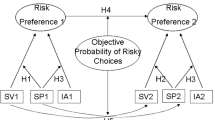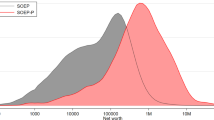Abstract
This paper empirically examines the role of personal capital in the entry decision for US high-technology entrepreneurs. Our innovative approach utilizes both survey data and data from economics-based field experiments, which enables us to elicit and control for the risk attitudes of individual entrepreneurs in the study. Empirical findings suggest that (1) Small Business Innovation Research (SBIR) grants, (2) credit cards, and (3) earnings from a salaried job are among the most important sources of funds for entrepreneurs in their decision to start up a firm. Our findings support Evans and Jovanovic (Journal of Political Economy 97(4):808–827, 1989) in that wealth appears to have a positive impact on the probability of starting up a firm, even when controlling for risk attitudes; however, risk attitudes do not appear to have a strong role to play in the entry decision overall. Policy implications suggest that firm start-ups are dependent on access to capital in both initial and early stages of development, and that government funding, including SBIR grants, is an important source of capital for potential and nascent high-technology entrepreneurs.
Similar content being viewed by others
Notes
By direct effects, we mean that risk-averse individuals may be less likely to leave salaried employment to start their own firm (Parker 2004).
Kan and Tsai (2006) control for risk attitude in their study on the importance of wealth.
Stiglitz and Weiss (1981) argue that as the rate of interest rises, so does the riskiness of borrowers, leading suppliers of capital to limit the quantity of loans they make. Most potential lenders have little information on the managerial capabilities or investment opportunities of such firms and are unlikely to be able to screen out poor credit risks or to have control over a borrower's investments. Also if lenders are unable to identify the quality or risk associated with particular borrowers, Jaffe and Russell (1976) show that credit rationing will occur.
Salient rewards refer to an experimental design where the payoffs increase with performance in order to induce subject behavior consistent real world competitive environments. Although for smaller payouts as in this study, this appears to be less of an issue (Holt and Laury 2002).
Use of experimental data by design does involve using not a random sample of the general population.
Their study uses survey data from 300 Australian students to measure risk preferences from responses to questions regarding hypothetical preferences for salary (low risk) versus performance-based bonuses (high risk).
If wealthier individuals have an easier time starting a firm then a positive relationship between wealth and the probability of starting a firm is evidence in itself that there are liquidity constraints (Evans and Jovanovic 1989, p. 819). In the absence of data on individual wealth before starting the firm, we use assets of the nascent firm as a proxy to measure and control for wealth effects—per Evans and Jovanovic (1989). This measure is consistent with the fact that there is often little distinction between personal wealth and the assets of the young entrepreneurial firm. In fact, from a lender’s perspective, the corporate veil is indeed thin for new firms, with owner's personal assets often being used as collateral for firm loans.
While the interdisciplinary literature on entrepreneurship refers to the process of starting a firm as: firm start-up, entry, the entrepreneurial decision, the entry decision, self-employment, etc., we will hereinafter use the term entry to denote this process.
From discussions with entrepreneurs, we found that for accounting and tax reasons, some entrepreneurs chose to take their compensation in the form of a salary. In examining the data, there were two cases in which salaried part-time entrepreneurs received SBIR grants and five cases where full-time entrepreneurs were recipients.
See Elston et al. (2005) for details on the series of experimental tasks that generated this data.
In fact we elicit individual CRRA intervals rather than use ones predicted by statistical models, so the CRRA measures are not subject to sampling error in this context.
Empirical studies use different measures to proxy for the importance of wealth. For example, Evans and Jovanovic (1989) use assets, wages, and earnings as proxies for individual wealth. Kan and Tsai (2006) use personal assets, and Georgellis et al. (2005) rely on the reported inheritance of individuals.
Since our experiments were one shot, we do not have the option of lagging variables over time to control for the potential endogeneity of independent variables.
In a related study on part-time entrepreneurs, Levesque and Schade (2005) examine how entrepreneurs divide time between working a wage job and working in their newly formed firm.
Entrepreneurs who also held salaried positions outside of their entrepreneurial firm are still classified as entrepreneurs as opposed to salaried non-entrepreneurs; in estimations we found that if we pool the two types of entrepreneurs, the data simply exhibit a wider variance in risk attitudes.
For details, see Elston et al. (2005).
Note when r = 1, U(y) = ln(y).
One can speculate that since secondary jobs are generally less common in Europe that this may negatively impact the ability of Europeans entrepreneurs to finance new firms.
An alternative interpretation is that while neither Race nor Age are statistically significant, they are almost significant in the model without control variables, which may indicate that the age of the entrepreneur has a potentially positive impact and being non-Caucasian has a potentially negative impact on the probability of starting a firm.
Wessner (2002).
The data on gifts and inheritance were pooled into one variable because there were too few observations on gifts.
References
Bates, T. (1990). Entrepreneur human capital inputs and small business longevity. The Review of Economics and Statistics, 72(4), 551–559.
Blanchflower, D. G., & Meyer, B. (1994). A longitudinal analysis of young entrepreneurs in Australia and the United States. Small Business Economics, 6(1), 1–20.
Blanchflower, D. G., & Oswald, A. G. (1998). What makes an entrepreneur? Journal of Labor Economics, 16, 26–60.
Branscomb, L. M., & Auerswald, P. A. (2002). Between invention and innovation: An analysis of funding for early-stage technology development. NIST GCR 02-841 (p. 23). Gaithersburg, MD: NIST.
Cressy, R. (2000). Credit rationing or entrepreneurial aversion? An alternative explanation for the Evans and Jovanovic finding. Economic Letters, 66, 235–240.
de Meza, D., & Webb, D. C. (1987). Too much investment: A problem of asymmetric information. Quarterly Journal of Economics, 102, 281–292.
Douglas, E., & Shepherd, D. (2002). Self-employment as a career choice: Attitudes, entrepreneurial intentions, and utility maximization. Entrepreneurship Theory and Practice, 26, 81–90.
Elston, J. A., Harrison, G., & Rutström, E. E. (2005). Characterizing the entrepreneur using field experiments. Discussion paper, Department of Economics, College of Business Administration, University of Central Florida. http://cebr.dk/upload/harrison.pdf.
Evans, D. S., & Jovanovic, B. (1989). An estimated model of entrepreneurial choice under liquidity constraints. Journal of Political Economy, 97(4), 808–827.
Evans, D. S., & Leighton, L. S. (1989a). Some empirical aspects of entrepreneurship. American Economic Review, 79(3), 519–535.
Evans, D. S., & Leighton, L. S. (1989b). The determinants of changes in U.S. self-employment. Small Business Economics, 1(2), 11–120.
Evans, D. S., & Leighton, L. S. (1990). Small business formation by unemployed and employed workers. Small Business Economics, 2(4), 319–330.
Georgellis, Y., Sessions, J., & Tsitsianis, N. (2005). Windfalls, wealth, and the transition to self-employment. Small Business Economics, 25, 407–428.
Hart, O., & Moore, J. (1994). A theory of debt based on the inalienability of human capital. The Quarterly Journal of Economics, 109(4), 841–879.
Holt, C. A., & Laury, S. K. (2002). Risk aversion and incentive effects. The American Economic Review, 92, 1644–1655.
Jaffe, D. M., & Russell, T. (1976). Imperfect information, uncertainty and credit rationing. Quarterly Journal of Economics, 90, 651–666.
Kan, K. K., & Tsai, W. (2006). Entrepreneurship and risk aversion. Small Business Economics, 26, 465–474.
Keh, H. T., Foo, M. D., & Lim, B. C. (2002). Opportunity evaluation under risky conditions: The cognitive processes of entrepreneurs. Entrepreneurship Theory and Practice, 27(2), 125–148.
Levesque, M., & Schade, C. (2005). Intuitive optimizing: Experimental findings on time allocation decisions with newly formed ventures. Journal of Business Venturing, 20, 313–342.
Palich, L. E., & Bagby, D. R. (1995). Using cognitive theory to explain entrepreneurial risk-taking: Challenging conventional wisdom. Journal of Business Venturing, 10, 425–438.
Parker, S. (2004). The economics of self-employment and entrepreneurship. Cambridge: Cambridge University Press.
Parker, S. (2005). The economics of entrepreneurship: What we know and what we don’t. Discussion papers on entrepreneurship, growth, and public policy #1805. The Max Planck Institute for Research into Economic Systems.
Petersen, M. A., & Rajan, R. G. (1992). The benefits of firm-creditor relationships: Evidence from small business data. University of Chicago working paper #362.
Stiglitz, J., & Weiss, A. (1981). Credit rationing in markets with imperfect information. American Economic Review, 71, 393–410.
Wessner, C. (Ed.). (2002). The small business innovation research program: Challenges and opportunities. Washington, D.C.: National Academy Press.
Acknowledgements
We are grateful to Maria Minniti and Christian Schade for discussions on the material contained in this study. Elston thanks the Ewing Marion Kauffman Foundation for research support under grant no. 20070378.
Author information
Authors and Affiliations
Corresponding author
Rights and permissions
About this article
Cite this article
Elston, J.A., Audretsch, D.B. Financing the entrepreneurial decision: an empirical approach using experimental data on risk attitudes. Small Bus Econ 36, 209–222 (2011). https://doi.org/10.1007/s11187-009-9210-x
Received:
Accepted:
Published:
Issue Date:
DOI: https://doi.org/10.1007/s11187-009-9210-x
Keywords
- Entry
- Experimental data
- High-technology entrepreneurs
- Liquidity constraints
- Personal capital
- Risk attitudes
- SBIR




